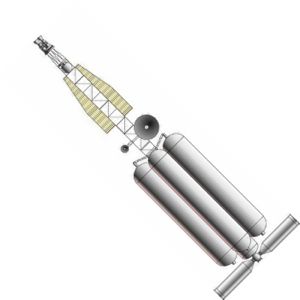
Home - Search - Browse - Alphabetic Index: 0- 1- 2- 3- 4- 5- 6- 7- 8- 9
A- B- C- D- E- F- G- H- I- J- K- L- M- N- O- P- Q- R- S- T- U- V- W- X- Y- Z
Mars 1994
 Keldysh Mars Credit: Jakob Terweij |
Status: Study 1994. Payload: 400,000 kg (880,000 lb). Thrust: 784.00 kN (176,250 lbf). Gross mass: 800,000 kg (1,760,000 lb). Specific impulse: 927 s. Height: 84.00 m (275.00 ft). Span: 18.00 m (59.00 ft).
By the 1980's test of the experimental RD-0410 nuclear thermal rocket engine had led to a definitive flight design. The design included bimodal use of the nuclear reactor to provide electrical power during dormant or cruise flight phases by means of a Brayton cycle turbine using xenon-helium coolant. The NPO Luch powerplant produced 20,000 kgf, with a thermal power of 1200 MW, operating time of 5 hours, and a specific impulse of between 815 and 927 seconds. During cruise operations the turbine would provide 50-200 kW of electric power, requiring 600 square meters of radiators. Two designs emerged using a cluster of three to four of these engines with a total powerplant mass of 50 to 70 metric tons. The 1989 layout of the Kurchatov Institute surrounded the crew quarters with liquid hydrogen propellant tanks to shield the crew from radiation from the reactors and cosmic rays. The radiators were positioned at the nose of the spacecraft. A more detailed 1994 design from the Keldysh Institute / NII-TP placed the radiators forward of the engines, followed by communications antennae, the living quarters (again surrounded by propellant tanks), followed by two large landing craft (one for Mars, one for Earth) docked laterally at the nose. The crew of five would complete the trip to Mars and back in 460 days. Total time of thrusting engine operation for the 800 metric ton, 84 m long craft was 6 hours.
From fore to aft the spacecraft consisted of:
- The Mars landing craft, in the familiar cylinder with conical nose configuration, 3.8 m in diameter and 13 m long
- The Earth return craft, in the same configuration as the Mars lander.
- The Living Quarters, with a Mir-type spherical docking unit at the nose, 5.5 m in diameter and 33 m long. This was divided into two sections, with a spherical airlock section dividing them. The forward section was equipped with a long manipulator arm for moving landers or modules around the docking unit. A radiation storm cellar was enclosed within the aft section for protection of the crew during solar storms.
- Six 36.5 m long tanks for storage of the liquid hydrogen, arranged around the living quarters. Four containing the earth-boost propellant were 6 m in diameter while two with the Mars braking and departure propellant were 5 m in diameter.
- A 3 m wide spar ran from the base of the crew quarters to the nuclear power plant. The first 18 m of the spar were used to mount communications antennae, followed by an 18 m section with radiators for rejecting reactor heat during cruise operations.
- The final 11.5 m long propulsion section, with 3 or 4 engines
Propellant made up about half of the total starting spacecraft mass.
Mars 1994 Mission Summary:
- Summary: Post-Soviet design by Kurchatov Institute for a nuclear thermal powered Mars expedition using the proven RD-0410 engine.
- Propulsion: Nuclear thermal
- Braking at Mars: propulsive
- Mission Type: opposition
- Split or All-Up: all up
- ISRU: no ISRU
- Launch Year: 2010
- Crew: 5
- Mars Surface payload-metric tons: 60
- Outbound time-days: 200
- Mars Stay Time-days: 30
- Return Time-days: 230
- Total Mission Time-days: 460
- Total Payload Required in Low Earth Orbit-metric tons: 800
- Total Propellant Required-metric tons: 400
- Propellant Fraction: 0.50
- Mass per crew-metric tons: 160
- Launch Vehicle Payload to LEO-metric tons: 88
- Number of Launches Required to Assemble Payload in Low Earth Orbit: 9
- Launch Vehicle: Energia
Crew Size: 5. Electric System: 200.00 average kW.
Family: Mars Expeditions. Country: Russia. Launch Vehicles: Mars tactical rocket, Energia. Propellants: Nuclear/LH2. Agency: Kurchatov bureau.
 | Kurchatov Mars Space Nuclear-thermal Mars expedition spacecraft as designed by the Kurchatov Institute in 1989. Credit: © Mark Wade |
 | 1994 NTR Mars Design Nuclear thermal Mars spacecraft design by NII-TP/Keldysh Institute. |
Back to top of page
Home - Search - Browse - Alphabetic Index: 0- 1- 2- 3- 4- 5- 6- 7- 8- 9
A- B- C- D- E- F- G- H- I- J- K- L- M- N- O- P- Q- R- S- T- U- V- W- X- Y- Z
© 1997-2019 Mark Wade - Contact
© / Conditions for Use